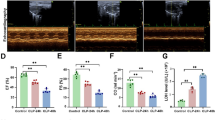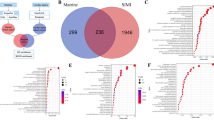Abstract
Thaliporphine was found to ameliorate endotoxin-induced circulatory failure and mortality in rodents. The aims of the present study were to assess whether thaliporphine could improve cardiac function in endotoxemic rats and to investigate the underlying mechanisms. Cardiac function was evaluated by pressure–volume loop analysis in pentobarbital-anesthetized rats 24 h after intravenous injection of lipopolysaccharide (LPS) (4 mg/kg) with or without thaliporphine (1 mg/kg, iv). The intracellular Ca2+ transients, nitric oxide (NO), and reactive oxygen species (ROS) in enzymatically isolated ventricular cells were measured by fluorescent indicators. Western blotting was used to analyze the change of protein expression in response to LPS with or without thaliporphine in rat ventricle, H9C2 and Raw264.7 cells. Cardiac depression was found to coincide with the decreased intracellular Ca2+ transients and the increased expression of nitrotyrosine on SERCA2 in rat ventricles after 24-h endotoxemia. Thaliporphine decreased intracellular NO and ROS level in ventricular cells and the nitrosylation of SERCA2, which resulted in recovering the functional properties of intracellular Ca2+ handling and cardiac contraction. In H9C2 cells, LPS-induced nuclear translocation of nuclear factor kappa B (NF-κB) could be attenuated by thaliporphine. In Raw264.7 cells, thaliporphine attenuated LPS-induced TAK-1 phosphorylation and IκBα degradation in association with the inhibition of inducible nitric oxide synthase (iNOS) and tumor necrosis factor alpha (TNF-α) expression and the production of NO and ROS. In conclusion, thaliporphine ameliorates LPS-induced cardiac depression through attenuating TLR4 signaling in the downstream of TAK-1 phosphorylation and NF-κB signaling in both cardiomyocytes and macrophage to prevent cardiac SERCA2 from nitrosylation by peroxynitrite via decreasing iNOS and TNF-α expression.







Similar content being viewed by others
Abbreviations
- LPS:
-
Lipopolysaccharide
- TLR-4:
-
Toll-like receptor 4
- iNOS:
-
Inducible nitric oxide synthase
- COX-2:
-
Cyclooxygenase 2
- TNF-α:
-
Tumor necrosis factor alpha
- NCX:
-
Sodium calcium exchanger
- SERCA-2:
-
Sarcoplasmic reticulum Ca2+-ATPase
- PLB:
-
Phospholamban
- CXN43:
-
Connexin 43
- NO:
-
Nitric oxide
- ROS:
-
Reactive oxygen species
References
Adachi T, Matsui R, Xu S, Kirber M, Lazar HL, Sharov VS, Schoneich C, Cohen RA (2002) Antioxidant improves smooth muscle sarco/endoplasmic reticulum Ca(2+)-ATPase function and lowers tyrosine nitration in hypercholesterolemia and improves nitric oxide-induced relaxation. Circ Res 90:1114–1121
Baumgarten G, Knuefermann P, Schuhmacher G, Vervolgyi V, von Rappard J, Dreiner U, Fink K, Djoufack C, Hoeft A, Grohe C, Knowlton AA, Meyer R (2006) Toll-like receptor 4, nitric oxide, and myocardial depression in endotoxemia. Shock 25:43–49
Beckman JS, Koppenol WH (1996) Nitric oxide, superoxide, and peroxynitrite: the good, the bad, and ugly. Am J Physiol 271:C1424–C1437
Boyd JH, Mathur S, Wang Y, Bateman RM, Walley KR (2006) Toll-like receptor stimulation in cardiomyocytes decreases contractility and initiates an NF-kappaB dependent inflammatory response. Cardiovasc Res 72:384–393
Cain BS, Meldrum DR, Dinarello CA, Meng X, Joo KS, Banerjee A, Harken AH (1999) Tumor necrosis factor-alpha and interleukin-1beta synergistically depress human myocardial function. Crit Care Med 27:1309–1318
Chen KH, Reece LM, Leary JF (1999) Mitochondrial glutathione modulates TNF-alpha-induced endothelial cell dysfunction. Free Radic Biol Med 27:100–109
Chiao CW, Lee SS, Wu CC, Su MJ (2005) Thaliporphine increases survival rate and attenuates multiple organ injury in LPS-induced endotoxaemia. Naunyn-Schmiedeberg’s Arch Pharmacol 371:34–43
Court O, Kumar A, Parrillo JE (2002) Clinical review: myocardial depression in sepsis and septic shock. Crit Care 6:500–508
Das UN (2003) Current advances in sepsis and septic shock with particular emphasis on the role of insulin. Med Sci Monit 9:RA181–RA192
Davani EY, Boyd JH, Dorscheid DR, Wang Y, Meredith A, Chau E, Singhera GK, Walley KR (2006) Cardiac ICAM-1 mediates leukocyte-dependent decreased ventricular contractility in endotoxemic mice. Cardiovasc Res 72:134–142
Digerness SB, Harris KD, Kirklin JW, Urthaler F, Viera L, Beckman JS, Darley-Usmar V (1999) Peroxynitrite irreversibly decreases diastolic and systolic function in cardiac muscle. Free Radic Biol Med 27:1386–1392
Frantz S, Ertl G, Bauersachs J (2007) Mechanisms of disease: Toll-like receptors in cardiovascular disease. Nat Clin Pract Cardiovasc Med 4:444–454
Gleeson M, McFarlin B, Flynn M (2006) Exercise and Toll-like receptors. Exerc Immunol Rev 12:34–53
Guinaudeau H, Leboeuf M, Cave A (1975) Aporphine alkaloids. Lloydia 38:275–338
Hicks MJ, Shigekawa M, Katz AM (1979) Mechanism by which cyclic adenosine 3′:5′-monophosphate-dependent protein kinase stimulates calcium transport in cardiac sarcoplasmic reticulum. Circ Res 44:384–391
Hove-Madsen L, Bers DM (1993) Sarcoplasmic reticulum Ca2+ uptake and thapsigargin sensitivity in permeabilized rabbit and rat ventricular myocytes. Circ Res 73:820–828
Jones SB, Romano FD (1990) Myocardial beta adrenergic receptor coupling to adenylate cyclase during developing septic shock. Circ Shock 30:51–61
Kameswara Rao NS, Lee SS (2000) Preparation of thaliporphine and lirioferine from glaucine by treatment with hydrogen bromide. J Chin Chem Soc 47:1227–1230
Kindt S, Van Oudenhove L, Broekaert D, Kasran A, Ceuppens JL, Bossuyt X, Fischler B, Tack J (2009) Immune dysfunction in patients with functional gastrointestinal disorders. Neurogastroenterol Motil 21:389–398
Krunkosky TM, Martin LD, Fischer BM, Voynow JA, Adler KB (2003) Effects of TNFalpha on expression of ICAM-1 in human airway epithelial cells in vitro: oxidant-mediated pathways and transcription factors. Free Radic Biol Med 35:1158–1167
Kumar A, Thota V, Dee L, Olson J, Uretz E, Parrillo JE (1996) Tumor necrosis factor alpha and interleukin 1beta are responsible for in vitro myocardial cell depression induced by human septic shock serum. J Exp Med 183:949–958
Kumar A, Haery C, Parrillo JE (2000) Myocardial dysfunction in septic shock. Crit Care Clin 16:251–287
Le Peuch CJ, Haiech J, Demaille JG (1979) Concerted regulation of cardiac sarcoplasmic reticulum calcium transport by cyclic adenosine monophosphate dependent and calcium–calmodulin-dependent phosphorylations. Biochemistry 18:5150–5157
Levy RJ (2007) Mitochondrial dysfunction, bioenergetic impairment, and metabolic down-regulation in sepsis. Shock 28:24–28
Liaudet L, Soriano FG, Szabo C (2000) Biology of nitric oxide signaling. Crit Care Med 28:N37–N52
Lo SK, Janakidevi K, Lai L, Malik AB (1993) Hydrogen peroxide-induced increase in endothelial adhesiveness is dependent on ICAM-1 activation. Am J Physiol 264:L406–L412
Lokuta AJ, Maertz NA, Meethal SV, Potter KT, Kamp TJ, Valdivia HH, Haworth RA (2005) Increased nitration of sarcoplasmic reticulum Ca2+-ATPase in human heart failure. Circulation 111:988–995
Marui N, Offermann MK, Swerlick R, Kunsch C, Rosen CA, Ahmad M, Alexander RW, Medford RM (1993) Vascular cell adhesion molecule-1 (VCAM-1) gene transcription and expression are regulated through an antioxidant-sensitive mechanism in human vascular endothelial cells. J Clin Invest 92:1866–1874
Merx MW, Weber C (2007) Sepsis and the heart. Circulation 116:793–802
Milanowski DJ, Winter RE, Elvin-Lewis MP, Lewis WH (2002) Geographic distribution of three alkaloid chemotypes of Croton lechleri. J Nat Prod 65:814–819
Mitra R, Morad M (1985) A uniform enzymatic method for dissociation of myocytes from hearts and stomachs of vertebrates. Am J Physiol 249:H1056–H1060
Parratt JR (1998) Nitric oxide in sepsis and endotoxaemia. J Antimicrob Chemother 41(Suppl A):31–39
Pathan N, Hemingway CA, Alizadeh AA, Stephens AC, Boldrick JC, Oragui EE, McCabe C, Welch SB, Whitney A, O'Gara P, Nadel S, Relman DA, Harding SE, Levin M (2004) Role of interleukin 6 in myocardial dysfunction of meningococcal septic shock. Lancet 363:203–209
Remick DG (2003) Cytokine therapeutics for the treatment of sepsis: why has nothing worked? Curr Pharm Des 9:75–82
Ren J, Ren BH, Sharma AC (2002) Sepsis-induced depressed contractile function of isolated ventricular myocytes is due to altered calcium transient properties. Shock 18:285–288
Rudiger A, Singer M (2007) Mechanisms of sepsis-induced cardiac dysfunction. Crit Care Med 35:1599–1608
Salinas J, Fica A (2005) Immunoglobulins in sepsis and septic shock. Rev Chil Infectol 22:21–31
Schmidt T, Zaib F, Samson SE, Kwan CY, Grover AK (2004) Peroxynitrite resistance of sarco/endoplasmic reticulum Ca2+ pump in pig coronary artery endothelium and smooth muscle. Cell Calcium 36:77–82
Sharma AC (2007) Sepsis-induced myocardial dysfunction. Shock 28:265–269
Stade BG, Messer G, Riethmuller G, Johnson JP (1990) Structural characteristics of the 5′ region of the human ICAM-1 gene. Immunobiology 182:79–87
Suematsu N, Tsutsui H, Wen J, Kang D, Ikeuchi M, Ide T, Hayashidani S, Shiomi T, Kubota T, Hamasaki N, Takeshita A (2003) Oxidative stress mediates tumor necrosis factor-alpha-induced mitochondrial DNA damage and dysfunction in cardiac myocytes. Circulation 107:1418–1423
Tavener SA, Kubes P (2006) Cellular and molecular mechanisms underlying LPS-associated myocyte impairment. Am J Physiol Heart Circ Physiol 290:H800–H806
Tavener SA, Long EM, Robbins SM, McRae KM, Van Remmen H, Kubes P (2004) Immune cell Toll-like receptor 4 is required for cardiac myocyte impairment during endotoxemia. Circ Res 95:700–707
Voraberger G, Schafer R, Stratowa C (1991) Cloning of the human gene for intercellular adhesion molecule 1 and analysis of its 5′-regulatory region. Induction by cytokines and phorbol ester. J Immunol 147:2777–2786
Werdan K, Muller U, Reithmann C, Pfeifer A, Hallstrom S, Koidl B, Schlag G (1991) Mechanisms in acute septic cardiomyopathy: evidence from isolated myocytes. Basic Res Cardiol 86:411–421
Xu S, Ying J, Jiang B, Guo W, Adachi T, Sharov V, Lazar H, Menzoian J, Knyushko TV, Bigelow D, Schoneich C, Cohen RA (2006) Detection of sequence-specific tyrosine nitration of manganese SOD and SERCA in cardiovascular disease and aging. Am J Physiol Heart Circ Physiol 290:H2220–H2227
Zhu X, Bernecker OY, Manohar NS, Hajjar RJ, Hellman J, Ichinose F, Valdivia HH, Schmidt U (2005) Increased leakage of sarcoplasmic reticulum Ca2+ contributes to abnormal myocyte Ca2+ handling and shortening in sepsis. Crit Care Med 33:598–604
Acknowledgements
This work was supported by grants from the National Science Council (NSC 95-2323-B-002-013), Taiwan.
Author information
Authors and Affiliations
Corresponding author
Rights and permissions
About this article
Cite this article
Chen, WP., Tzeng, HJ., Ku, HC. et al. Thaliporphine ameliorates cardiac depression in endotoxemic rats through attenuating TLR4 signaling in the downstream of TAK-1 phosphorylation and NF-κB signaling. Naunyn-Schmied Arch Pharmacol 382, 441–453 (2010). https://doi.org/10.1007/s00210-010-0562-1
Received:
Accepted:
Published:
Issue Date:
DOI: https://doi.org/10.1007/s00210-010-0562-1




